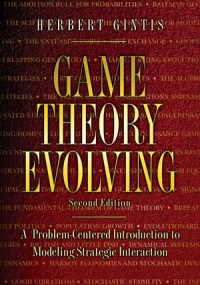Reviewed by
Rense Corten
Department of Sociology/ICS, Utrecht University
 The second edition of Game Theory Evolving, the game theory textbook by eminent economist Herbert Gintis, appears nine years after its first edition. Like its predecessor, it is subtitled A Problem-Centered Introduction to Modeling Strategic Interaction. The subtitle indicates that this is no ordinary textbook: it is based on the assumption that learning comes by doing, and therefore introduces the material through hands-on problems rather than 'straightforward' explanation.
The second edition of Game Theory Evolving, the game theory textbook by eminent economist Herbert Gintis, appears nine years after its first edition. Like its predecessor, it is subtitled A Problem-Centered Introduction to Modeling Strategic Interaction. The subtitle indicates that this is no ordinary textbook: it is based on the assumption that learning comes by doing, and therefore introduces the material through hands-on problems rather than 'straightforward' explanation. This is certainly not an approach to please everyone. In effect, the book reads like a collection of problems and answers only now and then interrupted by bits of explanation. While this may indeed be a good way for newcomers to familiarize themselves with game-theoretical analysis, it makes the book less useful as a reference. Where expert reviewers have heralded the quality the material of the first edition, a reader used to more traditional approaches to textbooks was likely to be frustrated by its lack of a structured story and a somewhat chaotic overall impression.
This second edition starts with two chapters on probability theory, decision theory, and Bayesian decision theory, providing foundations for the third chapter in which the basic concepts of game theory are introduced. These basics are elaborated in chapters 4-6, which discuss eliminating dominated strategies and pure- and mixed-strategy Nash equilibria. Gintis then moves on to the more specific topics of principal-agent models, signaling games, and repeated games. In the final quarter of the book, the emphasis shifts to topics characteristic of evolutionary game theory: evolutionary stable strategies (Ch. 10), dynamical systems (Ch. 11), evolutionary dynamics (i.e., replicator dynamics, Ch. 12), and stochastic dynamical systems (Ch.13). This comprehensive range of topics, including both classic game theory and system dynamics, sets this book apart from many of its competitors who typically focus on one of both. And unlike many other game theorists, Gintis does not shy away from agent-based models, which are discussed in various places.
Chapters typically start with a brief introduction to the topic at hand, after which increasingly complex problems highlight different aspects of the subject, often deriving key results in the process. The problems cover a broad range of important applications in economics, other social sciences, and the life sciences. The style of writing is lucid and often humorous. Solutions to many problems are provided at the end of the book. Some of these are rather sketchy, which can be frustrating to readers studying independently. Some routine in formal reasoning and mathematics is certainly needed to solve most problems. A minor annoyance is that the text does not indicate which problems do have solutions included, leading to much unsuccessful browsing back and forth.
What has changed as compared to the first edition? A first difference is that the book has considerably decreased in volume. The second edition has three fewer chapters as compared to the first edition and has over 25% fewer pages, even given a noticeably more spacious layout. Among the topics that have been sacrificed are behavioral game theory and learning in games with incomplete information (at least as dedicated chapters; some of these topics do reappear briefly in other chapters). We can only guess about the underlying reasons (the preface, unfortunately, does not detail differences between the editions), but I find these choices surprising given the ever-increasing impact of behavioral approaches on economic thinking. Aside from specific topics, the text also seems to have been shortened overall, giving the impression that often explanation has been shortened in favor of additional problems.
Second, the content has been thoroughly reordered as compared to the first version, and nearly all chapters have been renamed. In some cases, I find the choices made in this reordering questionable: for instance, the book now starts with two chapters on probability theory and Bayesian decision theory before introducing the basics of game theory only in Chapter three. Chapter two, especially, which lays out the mathematical foundations of the rational actor model, is in my opinion far too formal and abstract for its position in the book. In some places it seems that sections have not yet been fully adapted to their new place in the book; sometimes new concepts are used before being introduced, while other concepts are introduced twice.
The upshot is that Game Theory Evolving, 2nd Edition is, like the first edition, a great and comprehensive source of problems, covering a broad range of topics. It will prove to be extremely useful in learning game theory, although for many readers it should probably be supplemented with additional instruction or a more traditional straightforward textbook. The book as a whole however still makes a somewhat unpolished impression, and I am not convinced of its improvement over the first edition. In this regard, Gintis and his publisher missed an opportunity to turn Game Theory Evolving into a truly great textbook.
Return to Contents
of this issue
© Copyright Journal of Artificial Societies and Social Simulation, 2009